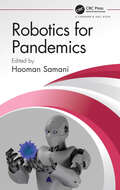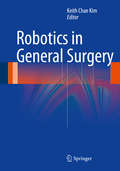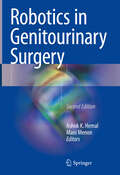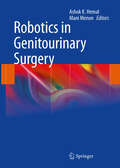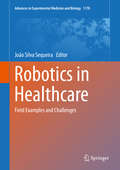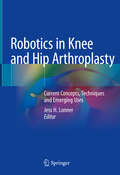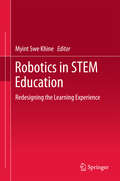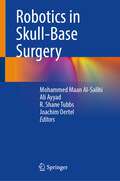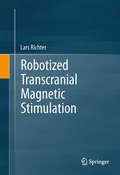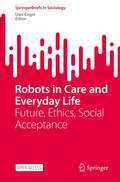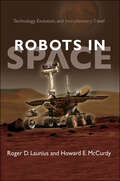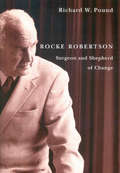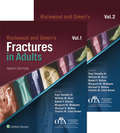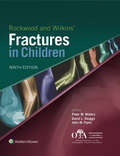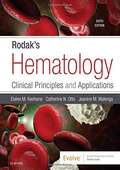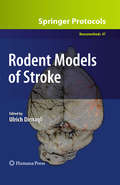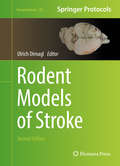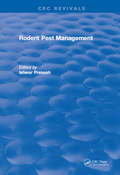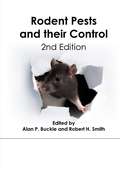- Table View
- List View
Robotics for Pandemics
by Hooman SamaniRobotics for Pandemics explores various applications of robots for current global issues such as pandemics and how robotic solutions could combat the virus. Key Features Proposes to employ robots to improve the treatment of patients and leverage the load of the medical system Demonstrates the concept of various robotics in healthcare telepresence, rehabilitation, therapy and delivery robots to accommodate social distancing Explores social robot aesthetics and how social interaction and embodied experiences could be useful during social isolation Includes anecdotes from applications used during the COVID-19 pandemic This will be a valuable reference to professionals, academics and researchers in the field of robotics.
Robotics in General Surgery
by Keith Chae KimRobotics in General Surgery provides a comprehensive review of the current applications of the robotic platform in all the general surgery subspecialties. Additionally, for each subspecialty it serves as a procedure-oriented instruction manual in terms of technical details of procedures, including fundamentals of robot positioning and trocar placement, step-by-step description of procedures, comprehensive discussions of advantages, limitations, indications, and relative contraindications of using the robotic approach. The text also discusses the challenges and steps to overcoming these challenges in transitioning from a minimally invasive to a robotic practice/surgeon. Lastly, this volume addresses emerging technology in robotics and the impact that the robotics platform will have on not only practice of surgery, but also in the education of surgeons at all levels. Written by experts in the field of robotic surgery, Robotics in General Surgery is a valuable resource for general surgeons of all levels including residents, fellows and surgeons already in practice.
Robotics in Genitourinary Surgery
by Mani Menon Ashok K. HemalThis updated volume provides a comprehensive guide to the recent developments of digital and intelligent technologies related to genitourinary surgery. New topics include the adaptation of simulators, training programs, standardized credentialing, evidence-based practice, as well as the economics of robotic surgery. The impact on public and global health is also covered. Robotics in Genitourinary Surgery aims to help surgeons and patients adopt the techniques and procedures discussed, and in turn educate and expand research activities within the field.
Robotics in Genitourinary Surgery
by Mani Menon Ashok Kumar HemalRobotics in Genito-Urinary Surgery fills the void of information on robotic urological surgery; a topic that is currently highly in demand and continuously increasing. This book provides detailed information on the utility of robotic urological surgery and how to use it most effectively. Robotics in Genito-Urinary Surgery comprehensively covers specialist areas such as female urology, pelvic floor reconstructions and holds a strong focus on pediatric urology. It also presents the main operative techniques through the use of high quality images and drawings. Compiled by expert authors from the USA, Europe and Asia, this book provides an international perspective on the basic knowledge and clinical management required for the optimal care of patients.
Robotics in Healthcare: Field Examples and Challenges (Advances in Experimental Medicine and Biology #1170)
by João Silva SequeiraThe work is a collection of contributions resulting from R&D efforts originated from scientific projects involving academia, technological partners, and end-user institutions. The aim is to provide a comprehensive overview of robotics technology applied to Healthcare, and discuss the anticipation of upcoming challenges.The intersection of Robotics and Medicine includes socially and economically relevant areas, such as rehabilitation, therapy, and healthcare. Innovative usages of current robotics technologies are being somewhat stranded by concerns related to social dynamics. The examples covered in this volume show some of the potential societal benefits robotics can bring and how the robots are being integrated in social environments.Despite the aforementioned concerns, a fantastic range of possibilities is being opened. The current trend in social robotics adds to technology challenges and requires R&D to think about Robotics as an horizontal discipline, intersecting social and exact sciences. For example, robots that can act as if they have credible personalities (not necessarily similar to humans) living in social scenarios, eventually helping people. Also, robots can move inside the human body to retrieve information that otherwise is difficult to obtain. The decision autonomy of these robots raises a broad range of subjects though the immediate advantages of its use are evident.The book presents examples of robotics technologies tested in healthcare environments or realistically close to being deployed in the field and discusses the challenges involved. Chapter 1 provides a comprehensive overview of Healthcare robotics and points to realistically expectable developments in the near future. Chapter 2 describes the challenges deploying a social robot in the Pediatrics ward of an Oncological hospital for simple edutainment activities. Chapter 3 focuses on Human-Robot Interaction techniques and their role in social robotics. Chapter 4 focus on R&D efforts behind an endoscopic capsule robot. Chapter 5 addresses experiments in rehabilitation with orthotics and walker robots. These examples have deep social and economic relations with the Healthcare field, and, at the same time, are representative of the R&D efforts the robotics community is developing.
Robotics in Knee and Hip Arthroplasty: Current Concepts, Techniques and Emerging Uses
by Jess H. LonnerThis state-of-the-art book focuses specifically on the current and emerging uses of robotics for knee and hip arthroplasty, with an expanding market anticipated, particularly as costs drop, data emerges and surgical efficiencies improve. It is divided into four main sections. Part one covers the background and basic principles of robotics in orthopedic surgery, discussing its history and evolution, current concepts and available technologies, perioperative protocols for recovery and pain management, economic considerations, and risks and complications. The second and third parts focus on the techniques themselves for the knee and hip respectively, including unicompartmental and bicompartmental knee arthroplasty, patellofemoral arthroplasty, and total knee and hip arthroplasty utilizing Navio, Mako, iThink, Omni and ROSA Knee robots. The final section presents the emerging use of robotics in spine surgery as well as for hospital process improvement. Presenting the most current techniques, technology and evidence, Robotics in Knee and Hip Arthroplasty will be a valuable resource for orthopedic surgeons, residents and fellows looking to implement and utilize these developing management strategies in their clinical practice.
Robotics in Neurosurgery: Principles and Practice
by Jorge Alvaro González Martínez Francesco CardinaleThis book provides a state-of-the art review of this field and demonstrates the basic applications of robotic surgery in the field of neurosurgery, exposing its basic principles, practical technical nuances, and advantages and limitations related to the technology. It also provides a concise yet comprehensive summary of the current status of the field that will help guide patient management and stimulate investigative efforts. All chapters are written by experts in their fields and include the most up to date scientific and clinical information. Robotics in Neurosurgery: Principles and Practice will serve as a valuable resource for clinicians, surgeons, engineers and researchers dealing with, and interested in, this challenging and promising field in robotics applied to neurosurgery.
Robotics in Plastic and Reconstructive Surgery
by Jesse C. SelberThis book describes the current state of robotics in plastic and reconstructive surgery. It examines existing clinical applications, emerging and future applications and evolving technological platforms.Concise yet comprehensive, this book is organized into four sections. It begins with an introduction to robotic microsurgical training and robotic skills assessment, including crowd-sourced evaluation in surgery. Section two explores a variety of robotic clinical application, including robotic breast reconstruction, robotic mastectomy, robotic cleft palate surgery and robotic microsurgery in a urologic private practice. Following this, section three addresses the opportunities and challenges an interested surgeon might face when considering incorporating this technology into their practice. To close, the final section discusses new microsurgical robotic platforms and the potential directions this technology may take in the future. Supplemented with high quality videos and images, Robotics in Plastic and Reconstructive Surgery is an invaluable resource for both plastic surgeons and multi-specialty micro-surgeons.
Robotics in STEM Education
by Myint Swe KhineThis book describes recent approaches in advancing STEM education with the use of robotics, innovative methods in integrating robotics in school subjects, engaging and stimulating students with robotics in classroom-based and out-of-school activities, and new ways of using robotics as an educational tool to provide diverse learning experiences. It addresses issues and challenges in generating enthusiasm among students and revamping curricula to provide application focused and hands-on approaches in learning . The book also provides effective strategies and emerging trends in using robotics, designing learning activities and how robotics impacts the students' interests and achievements in STEM related subjects. The frontiers of education are progressing very rapidly. This volume brought together a collection of projects and ideas which help us keep track of where the frontiers are moving. This book ticks lots of contemporary boxes: STEM, robotics, coding, and computational thinking among them. Most educators interested in the STEM phenomena will find many ideas in this book which challenge, provide evidence and suggest solutions related to both pedagogy and content. Regular reference to 21st Century skills, achieved through active collaborative learning in authentic contexts, ensures the enduring usefulness of this volume. John Williams Professor of Education and Director of the STEM Education Research Group Curtin University, Perth, Australia
Robotics in Skull-Base Surgery
by R. Shane Tubbs Mohammed Maan Al-Salihi Ali Ayyad Joachim OertelThis book is the first book in the field of robotics in skull-base surgery. It uncovers the pioneering realm of robotics in skull-base surgery through this remarkable compendium. With a comprehensive exploration from neurosurgical and otolaryngological perspectives, it delves into the diverse applications of robotics, accompanied by a thorough literature review.The chapters run the gamut from using robotics for approaches to the anterior and lateral skull base to using this technology for more specific approaches such as transoral methods and radiosurgery.The major advantage of this work is its organization and systematic delivery of information, which makes it a reliable and comprehensible source for the medical professional. It is a “go-to” resource for all researchers, clinicians, and medical doctors who are interested in the most recent trends in robotics in skull-base in Neurosurgery and ENT surgery.
Robotized Transcranial Magnetic Stimulation
by Lars RichterRobotized Transcranial Magnetic Stimulation describes the methods needed to develop a robotic system that is clinically applicable for the application of transcranial magnetic stimulation (TMS). Chapter 1 introduces the basic principles of TMS and discusses current developments towards robotized TMS. Part I (Chapters 2 and 3) systematically analyzes and clinically evaluates robotized TMS. More specifically, it presents the impact of head motion on the induced electric field. In Part II (Chapters 3 to 8), a new method for a robust robot/camera calibration, a sophisticated force-torque control with hand-assisted positioning, a novel FTA-sensor for system safety, and techniques for direct head tracking, are described and evaluated. Part III discusses these developments in the context of safety and clinical applicability of robotized TMS and presents future prospects of robotized TMS. Robotized Transcranial Magnetic Stimulation is intended for researchers as a guide for developing effective robotized TMS solutions. Professionals and practitioners may also find the book valuable.
Robots in Care and Everyday Life: Future, Ethics, Social Acceptance (SpringerBriefs in Sociology)
by Uwe EngelThis open access book presents detailed findings about the ethical, legal, and social acceptance of robots in the German and European context. The key resource is the Bremen AI Delphi survey of scientists and politicians and a related population survey. The focus is on trust in robotic assistance, human willingness to use this assistance, and the expected personal well-being in human-robot interaction. Using recent data from Eurostat, the European Social Survey, and the Eurobarometer survey, the analysis is extended to Germany and the EU. The acceptance of robots in care and everyday life is viewed against their acceptance in other contexts of life and the scientific research. The book reports on how the probability of five complex future scenarios is evaluated by experts and politicians. These scenarios cover a broad range of topics, including the worst-case scenario of cutthroat competition for jobs, the wealth promise of AI, communication in human-robot interaction, robotic assistance, and ethical and legal conflicts. International economic competition alone will ensure that countries invest sustainably in the future technologies of AI and robots. But will these technologies also be accepted by the population? The book raises the core issue of how governments can gain the needed social, ethical, and user acceptance of AI and robots in everyday life. This highly topical book is of interest to researchers, professionals and policy makers working on various aspects of human-robot interaction. This is an open access book.
Robots in Space: Technology, Evolution, and Interplanetary Travel (New Series in NASA History)
by Roger D. Launius Howard E. McCurdy2008 Outstanding Academic Title, Choice MagazineGiven the near incomprehensible enormity of the universe, it appears almost inevitable that humankind will one day find a planet that appears to be much like the Earth. This discovery will no doubt reignite the lure of interplanetary travel. Will we be up to the task? And, given our limited resources, biological constraints, and the general hostility of space, what shape should we expect such expeditions to take?In Robots in Space, Roger Launius and Howard McCurdy tackle these seemingly fanciful questions with rigorous scholarship and disciplined imagination, jumping comfortably among the worlds of rocketry, engineering, public policy, and science fantasy to expound upon the possibilities and improbabilities involved in trekking across the Milky Way and beyond. They survey the literature—fictional as well as academic studies; outline the progress of space programs in the United States and other nations; and assess the current state of affairs to offer a conclusion startling only to those who haven't spent time with Asimov, Heinlein, and Clarke: to traverse the cosmos, humans must embrace and entwine themselves with advanced robotic technologies.Their discussion is as entertaining as it is edifying and their assertions are as sound as they are fantastical. Rather than asking us to suspend disbelief, Robots in Space demands that we accept facts as they evolve.
Rock, Paper, Scissors: And Other Stories
by Maxim OsipovThe first English-language collection of a contemporary Russian master of the short story.Maxim Osipov, who lives and practices medicine in a town ninety miles outside Moscow, is one of Russia’s best contemporary writers. In the tradition of Anton Chekhov and William Carlos Williams, he draws on his experiences in medicine to write stories of great subtlety and striking insight. Osipov’s fiction presents a nuanced, collage-like portrait of life in provincial Russia—its tragedies, frustrations, and moments of humble beauty and inspiration. The twelve stories in this volume depict doctors, actors, screenwriters, teachers, entrepreneurs, local political bosses, and common criminals whose paths intersect in unpredictable yet entirely natural ways: in sickrooms, classrooms, administrative offices and on trains and in planes. Their encounters lead to disasters, major and minor epiphanies, and—on occasion—the promise of redemption.
Rocke Robertson: Surgeon and Shepherd of Change
by Richard W. PoundRocke Robertson (1912 - 1998) was a McGill-trained surgeon who served at the front lines in the Sicilian and Italian campaigns in World War II. His post-war experience took him to the top of the medical profession and appointments as chief of the Department of Surgery at McGill and surgeon-in-chief at the Montreal General Hospital. In 1962 Robertson was named principal of McGill University, a position he held for eight years during one of the most unsettling periods in the university's history. Apart from the usual demanding job of running the university, Robertson was forced to deal with political upheaval, student unrest and revolt, and defending the rights of the English-speaking minority in Quebec. While all around him university leaders cracked under the pressures, Robertson persisted until workable governance solutions were put in place at McGill. Rocke Robertson: Surgeon and Shepherd of Change is a compelling portrait of a remarkable man who handled the greatest challenge of his career - running a primarily English-speaking university in Quebec during the Quiet Revolution - with courage, wisdom, and success.
Rockhaven Sanitarium: The Legacy of Agnes Richards (Landmarks)
by Elisa JordanFor decades, the mild climate of the Crescenta Valley served as a haven for those seeking mental health rest and relief from lung ailments. In 1923, registered nurse Agnes Richards decided it was the perfect place to open a sanitarium, one that would set itself apart from the rest. Rockhaven Sanitarium catered to female residents only and, with few exceptions, exclusively employed women. It was a progressive treatment center that prided itself on treating residents with dignity and respect. The center's high ideals and proximity to early Hollywood attracted residents like Billie Burke; Marilyn Monroe's mother, Gladys; and Clark Gable's first wife, Josephine Dillon. Join author Elisa Jordan as she explores Rockhaven's illustrious past.
Rockwood and Green's Fractures in Adults
by Paul Tornetta III William Ricci Charles M. Court-Brown Margaret M. McQueenThis exhaustive reference includes new chapters and pedagogical features, as well as—for the first time—content on managing fragility factures. To facilitate fast, easy absorption of the material, this edition has been streamlined and now includes more tables, charts, and treatment algorithms than ever before. Experts in their field share their experiences and offer insights and guidance on the latest technical developments for common orthopaedic procedures, including their preferred treatment options.
Rockwood and Wilkins Fractures in Children
by Peter M. Waters David L. Skaggs John M. FlynnWith contributions from experts in orthopaedic surgery, the latest edition of this comprehensive resource presents up-to-date technical procedures for treating a wide range of fractures in children and adolescents. Content and chapters are easier to read than ever before. How? All clinical sections follow a templatized format—as in previous editions—and now you’ll find even more treatment algorithms, checklists, charts, and tables, helping you quickly identify and apply critical information in a care situation.
Rocky Times
by Richard J. Herring Robert E. Litan Yasuyuki FuchitaIt has been four years since the financial crisis of 2008, and the global financial system still is experiencing malaise caused by high rates of unemployment; a lingering, unresolved supply of foreclosed properties; the deepening European debt crisis; and fear of a recurrence of the bank turmoil that brought about the Great Recession. All of these factors have led to stagnant economic growth worldwide.In Rocky Times, editors Yasuyuki Fuchita, Richard J. Herring, and Robert E. Litan bring together experts from academia and the banking sector to analyze the difficult issues surrounding troubled large financial institutions in an environment of economic uncertainty and growing public anger. Continuing the format of the previous Brookings- Nomura collaborations, Rocky Times focuses largely on developments within the United States and Japan but looks at those in other nations as well.This volume examines two broad areas: the Japanese approach to regulating financial institutions and promoting financial stability and the U.S. approach in light of the Dodd-Frank Act. Specific chapters include "Managing Systemwide Financial Crises: Some Lessons from Japan since 1990," "The Bankruptcy of Bankruptcy," "The Case for Regulating the Shadow Banking System," "Why and How to Design a Contingent Convertible Debt Requirement," and "Governance Issues for Macroprudential Policy in Advanced Economies."Contributors: Gavin Bingham (Systemic Policy Partnership, London), Charles W. Calomiris (Columbia Business School), Douglas J. Elliott (Brookings Institution), Kei Kodachi (Nomura Institute of Capital Markets Research), Morgan Ricks (Vanderbilt Law School).
Rodak's Hematology: Clinical Principles And Applications
by Elaine M. Keohane Jeanine M. Walenga Catherine N. OttoMake sure you are thoroughly prepared to work in a clinical lab. Rodak’s Hematology: Clinical Principles and Applications, 6th Edition uses hundreds of full-color photomicrographs to help you understand the essentials of hematology. This new edition shows how to accurately identify cells, simplifies hemostasis and thrombosis concepts, and covers normal hematopoiesis through diseases of erythroid, myeloid, lymphoid, and megakaryocytic origins. Easy to follow and understand, this book also covers key topics including: working in a hematology lab; complementary testing areas such as flow cytometry, cytogenetics, and molecular diagnostics; the parts and functions of the cell; and laboratory testing of blood cells and body fluid cells.
Rodent Bioacoustics (Springer Handbook of Auditory Research #67)
by Arthur N. Popper Richard R. Fay Micheal L. DentBy far, the most widely used subjects in psychological and biological research today are rodents. Although rats and mice comprise the largest group of animals used in research, there are over 2,000 species and 27 families of rodents, living all over the world (except Antarctica) and thriving in many different habitat types. The vast environmental diversity that rodents face has led to numerous adaptations for communication, including vocalizing and hearing in both the sonic and ultrasonic ranges, effectively communicating in the open air and underground, and using vocalizations for coordinating sexual behavior, for mother-pup interactions, and for signaling an alarming situation to the group. Some rodent species have even developed foot drumming behaviors for communication. Comparative studies from around the globe, using both field and laboratory methodologies, reveal the vast differences in acoustic communication behavior across many rodent species. Some rodents are amenable to training and have been domesticated and bred purely for research purposes. Since the early 1900s, rats and mice have been indispensable to research programs around the world. Thus, much of what we know about hearing and vocalizations in rodents come from these two species tested in the laboratory. The sequencing of the mouse genome in 2002, followed by the rat genome in 2004, only increased the utility of these animals as research subjects since genetically engineered strains mimicking human diseases and disorders could be developed more easily. In the laboratory, rats and mice are used as models for human communication and hearing disorders and are involved in studies on hearing loss and prevention, hormones, and auditory plasticity, to name a few. We know that certain strains of mice retain hearing better than others throughout their lifespan, and about the genes involved in those differences. We know about the effects of noise, hormones, sex, aging, and circadian rhythms on hearing in mice and other rodents. We also know about normal hearing in many families of rodents, including the perception of simple and complex stimuli and the anatomy and physiology of hearing and sound localization.The importance of acoustic communication to these animals, as well as the significance of these mammals to biomedical research, are summarized in the chapters.
Rodent Models of Stroke
by Ulrich DirnaglIn view of the numerous failures of clinical trials aimed at improving stroke therapy, the role and potential benefit of experimentally modeling focal cerebral ischemia in rodents has been debated. When methods of systematic review and metaanalyis are applied, however, it turns out that experimental models actually faithfully predicted the negative outcomes of clinical trials. In addition, thrombolysis and neuroprotection by hypothermia, first described in animal models, are key examples of treatment modalities that have made it successfully into clinical practice. In Rodent Models of Stroke, an international consortium of authors aims at critically addressing the issues on a very practical level, from choosing the model and outcome measures, designing the experiment, conducting and analyzing it, to reporting it in a scientific publication. The structure and content of the book reflect both the authors' longstanding expertise in experimental and clinical stroke research and their roles in training the scientific community in the tools of the trade. As a volume in the successful Neuromethods series, the chapters provide authoritative reviews of the most commonly used, well-honed approaches in the field today. Stimulating and easy-to-use, Rodent Models of Stroke will help its readers understand the limitations and the opportunities of modeling stroke in rodents and enable them to conduct experiments which will not only improve our understanding of the pathophysiology of this devastating disorder but also serve as the basis for developing new highly effective treatments.
Rodent Models of Stroke
by Ulrich DirnaglIn view of the numerous failures of clinical trials aimed at improving stroke therapy, the role and potential benefit of experimentally modeling focal cerebral ischemia in rodents has been debated. When methods of systematic review and metaanalyis are applied, however, it turns out that experimental models actually faithfully predicted the negative outcomes of clinical trials. In addition, thrombolysis and neuroprotection by hypothermia, first described in animal models, are key examples of treatment modalities that have made it successfully into clinical practice. In Rodent Models of Stroke, an international consortium of authors aims at critically addressing the issues on a very practical level, from choosing the model and outcome measures, designing the experiment, conducting and analyzing it, to reporting it in a scientific publication. The structure and content of the book reflect both the authors' longstanding expertise in experimental and clinical stroke research and their roles in training the scientific community in the tools of the trade. As a volume in the successful Neuromethods series, the chapters provide authoritative reviews of the most commonly used, well-honed approaches in the field today. Stimulating and easy-to-use, Rodent Models of Stroke will help its readers understand the limitations and the opportunities of modeling stroke in rodents and enable them to conduct experiments which will not only improve our understanding of the pathophysiology of this devastating disorder but also serve as the basis for developing new highly effective treatments.
Rodent Pest Management
by Ishwar PrakashThe objective of this multi-authored compendium is, therefore, to bring together the state of arts reported in one place. Written by specialists by specialists in various fields of rondentology, and to suggest future lines of research. It is also felt that this work on rodent pest management will trigger more research effort for the benefit of mankind and help certain countries and organizations in revitalizing serious work in this field which, it appears, has dampened during the last few years.
Rodent Pests and Their Control
by David Cowan Adrian Meyer Roger Quy Alan P Buckle Hans-Joachim Pelz David W Macdonald Brian Wood Stephen Battersby Richard Shore Robert H Smith Michael Fall Colin Prescott Grant SingletonThe most numerous of the world's invasive species, rodent pests have a devastating impact on agriculture, food, health and the environment. In the last two decades, the science and practice of rodent control has faced new legislation on rodenticides, the pests' increasing resistance to chemical control and the impact on non-target species, bringing a new dimension to this updated 2nd edition and making essential reading for all those involved in rodent pest control, including researchers, conservationists, practitioners and public health specialists.
